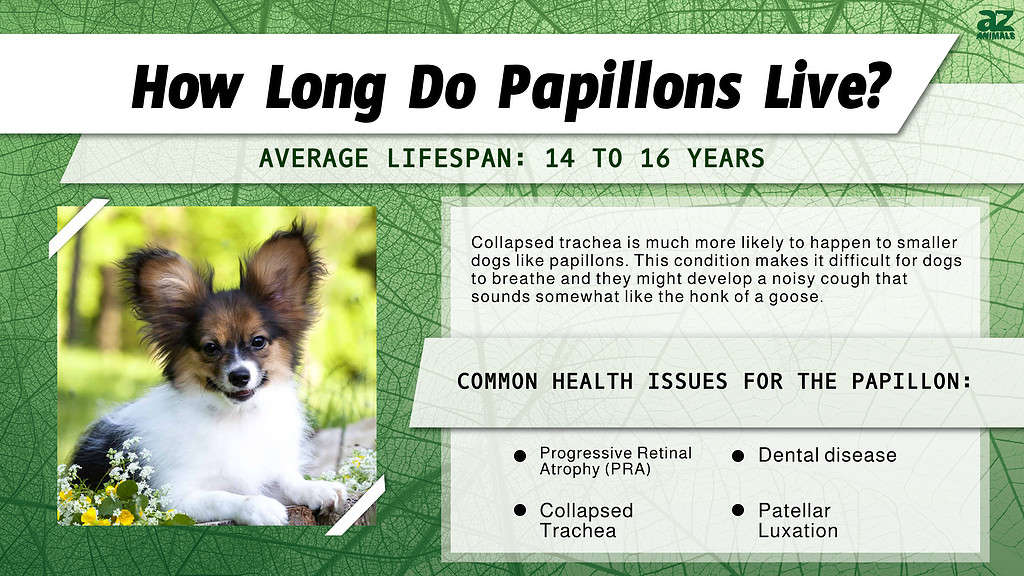Papillons are easy to recognize with their perky ears that look like delicate butterfly wings as well as their lively and lovable personalities. Although tiny, these sweet dogs are known for their adventurous spirits, and they absolutely love to play. Papillons are fearless and energetic pups who are always ready to accompany you on a new adventure. They are very loyal to their human companions and make beloved family pets. If you’re considering adopting one of these dainty little dogs, you may wonder, “How long do papillons live?” This article will give you everything you need to know, as well as some of the different aspects that can affect your papillon’s lifespan.

How Long Do Papillons Live?
Papillons live between 14 to 16 years on average. In general, this breed is pretty healthy and long-lived, although there are a few health issues to watch out for. The papillon is a tiny and delicate-looking dog that grows 8 to 11 inches at the shoulder and weighs 5 to 10 pounds. “Papillon” is a French term and refers to the dog’s large, fringed ears that look like butterfly wings. Although less common, some papillons can also have dropped ears (these dogs are referred to as phalène dogs).
Papillons are one of the oldest toy spaniel breeds. In fact, they’re featured in many famous paintings over the past few centuries. Some of the earliest examples come from the Italian painter Titian, such as his 1542 painting Venus of Urbino. Many other artists like Rembrandt, François Boucher, Jean-Honoré Fragonard, Veronese, and Jean-Antoine Watteau also painted these adorable little pups. Supposedly Marie Antoinette had a papillon pup, and there is even one included in a family portrait of the French King Louis XIV!

Papillon” means “butterfly” in French and refers to the dogs’ irresistibly cute butterfly-like ears.
©Anna Maloverjan/Shutterstock.com
How Old Was the Oldest Papillon to Ever Live?
Papillon dogs typically live long and healthy lives. In fact, according to a 2002 poll conducted by the Papillon Club of America, the average lifespan of these adorable pups was found to be 11.45 years. In the last 20 years, however, advances in veterinary medicine have increased this average to 14 to 16 years.
And of course, some papillons have even lived well beyond their expected age range. For example, a papillon named Chanel lived to the ripe old age of 21. Another named Scolly was 20 years old before he made his journey across the rainbow bridge.
Factors That Impact Papillon Lifespan
With an average lifespan of 14 to 16 years, these adorable butterfly-eared dogs are typically pretty healthy. However, just like with any dog breed, there are some health concerns that these dogs can develop. The key to helping keep your papillon healthy and happy is to watch for any changes in their physical movements, appearance, or behavior, and to take them to the vet as soon as possible so that they can get proper treatment. Let’s take a look at some of the common health concerns that can affect papillons’ overall lifespan and quality of life:
- Patellar luxation
- Dental disease
- Collapsed trachea
- Progressive Retinal Atrophy (PRA)
- Von Willebrand’s Disease
- Allergies
- Low Blood Sugar (Hypoglycemia)
Patellar Luxation
This condition is typically more common in small dog breeds like the papillon, although it’s becoming increasingly prevalent in larger breeds as well. Patellar luxation occurs when the patella, a small bone located in the knee, doesn’t line up correctly. If you take your dog to the vet for regular checkups, they may be able to detect this early on.
Symptoms of patellar luxation vary in severity, but in the early stages, you might notice your dog limping a few steps or having trouble using one of their legs. The more severe cases, however, may require surgery. So, it is essential to always pay attention to your dog’s movements and take them to the vet if you see any changes or suspect any problems.

Because of their size, papillons sometimes only give birth to one puppy in a litter.
©Malivan_Iuliia/Shutterstock.com
Dental Disease
Most small dog breeds are prone to dental problems. Papillons are especially prone to “retained puppy teeth”. This happens when the cute little puppies grow up, but their puppy teeth don’t fall out when the adult teeth start coming in. This can cause hair, food, and other particles to get trapped between the dog’s teeth. To prevent this from happening, your vet may recommend removing the puppy teeth if they don’t fall out naturally when they’re supposed to. So, if you adopt a papillon puppy it’s essential to pay close attention to their teeth. You should also work with your vet if they need any puppy teeth removed when they get older.
In addition, even papillons with healthy teeth should see a vet regularly to check for plaque and other dental issues that are common in small-breed dogs. It can be very helpful to brush your dog’s teeth, give them dental treats, or use dental additives with their water. They also may need to have their teeth cleaned regularly as well.
Collapsed Trachea
Although any dog breed can suffer from a collapsed trachea, it is much more likely to happen to smaller dogs like papillons. The trachea (or windpipe) is a tube that connects the throat and lungs. It is supported by small circular rings of connective tissue or cartilage, which help to keep the tube in place. As dogs mature these rings can weaken and start to flatten out, which can lead to a collapse of the trachea.
A collapsed trachea makes it difficult for dogs to breathe. They might also develop a noisy cough that sounds somewhat like the honk of a goose. It is usually more common in older dogs that are over four years old, dogs that are overweight, or dogs that live with smokers.
In addition, small dogs like papillons also have very delicate necks, so pulling on a leash or collar can also cause a collapsed trachea. These tiny dogs should be walked using a small harness rather than a collar to prevent this from happening.

It’s best to use a harness instead of a collar when walking small-breed dogs to prevent injuries.
©iStock.com/Norma Chambers
Progressive Retinal Atrophy (PRA)
This condition usually develops in adult dogs between the ages of three to nine years old. As time passes, the photoreceptor cells in their eyes begin to weaken, and can eventually lead to blindness. In the early stages, your dog may show signs of night blindness. They might have difficulty seeing in dim light or they may be afraid to go into dark rooms. You might also notice that their eyes look like they’re reflecting more light or that their pupils appear larger than normal.
Fortunately, there are treatments available for progressive retinal atrophy. So, if you notice any of these symptoms, be sure to take your dog to the vet right away. A vet can help create a plan to manage the condition and help to prevent any further damage.
Von Willebrand’s Disease
Papillon dogs can inherit a bleeding disorder called Von Willebrand’s Disease. This condition occurs when dogs have less than half of an essential protein needed for their blood to clot normally. Dogs with Von Willebrand’s Disease often bruise easily, have frequent nosebleeds, bleed from the mouth when their puppy teeth fall out, or bleed longer than usual after an injury or surgery. However, the severity can vary, so you might not know your dog has this disease until excessive bleeding happens after they get hurt, give birth, or have surgery.
Although Von Willebrand’s Disease can lead to death if too much bleeding occurs, most dogs can still live out a normal lifespan. You’ll just have to make sure that you pay very close attention to your dog and any bleeding that may occur. Since the disease does not always manifest immediately, you can also ask your vet for a screening test help to confirm whether or not your dog suffers from Von Willebrand’s Disease.
If your dog is diagnosed with Von Willebrand’s Disease, your vet can create a plan to manage their symptoms. They can also prepare blood banks and transfusions if your dog ever needs surgery.

The papillon is sometimes also called the continental toy spaniel.
©Anastasiia Cherniavskaia/Shutterstock.com
Allergies
Some papillons can develop a type of allergy that makes their skin incredibly itchy when they come into contact with things like dust, mold, and pollen. The itchiness is usually more prevalent on their ears, feet, skin folds, and stomach. It tends to develop in dogs who are one to three years old, and it can get worse over time.
If your dog suffers from this allergy, you might notice them licking their paws or rubbing their face a lot, or they might develop frequent ear infections. You should take your dog to the vet as soon as possible so that they can help manage the condition effectively with things like steroids, antihistamines, and dietary changes.
Low Blood Sugar (Hypoglycemia)
Due to their tiny bodies, toy dog breed puppies like papillons can struggle with low blood sugar or hypoglycemia. This is when their blood sugar levels become too low. While it is easy to treat in the early stages, unfortunately, it can be fatal if the dog does not receive help in time.
If you have a young papillon puppy it’s crucial to recognize the signs and symptoms of low blood sugar. You might notice that your puppy slows down and becomes listless, and this is often followed by trembling or shivering. If this happens to your papillon pup, you need to act quickly. Place some honey under their tongue and then get them to the vet immediately.

Many papillon lovers have reported that these little dogs do not have a “doggy odor”.
©iStock.com/Andybir
How to Help Your Papillon Live a Long and Healthy Life
Fortunately, the health concerns that papillons are most prone to have treatment options available and can be monitored safely by your vet. However, there are additional measures that you can also take to help provide your pup with the best life possible and ensure that they live a long and healthy life by your side. Let’s take a closer look at some of the crucial aspects of caring for your papillon:
- Breeders and Adoption
- Spaying and neutering
- Exercise
- Environment
- Sociality
- Love
Breeders and Adoption
Although papillon puppies are certainly adorable, you may also consider adopting an adult dog from a rescue group or an animal shelter. Many of their health conditions and behavioral issues don’t show up when they are puppies, so if you adopt an older dog you can better know what to expect.
If you want to adopt a dog from a breeder, be sure to find one who is approved by the Papillon Club of America and abides by the club’s code of ethics. Qualified breeders work hard to ensure the genetics and health of their pups are on par with these standards. You should also discuss health or behavioral concerns with the breeder. A good breeder will provide documentation from the Orthopedic Foundation for Animals and the Canine Eye Registry Foundation. These certify that your new pup has a healthy heart, and healthy knees and that they don’t suffer from any vision problems.
Whether you buy a puppy from a reputable breeder or you adopt one from a rescue, be sure to take your new dog to your vet for a physical exam as soon as possible. Your vet can spot any obvious issues and help work with you on preventative care so that you can avoid many of the health issues that papillons are prone to.
Spaying and Neutering
One of the best ways to help keep your papillon healthy is to make sure to spay or neuter them. Although it may sound scary, it’s actually a straightforward procedure and it offers many benefits for your dog. Spaying and neutering your papillon helps to reduce the chances of developing certain types of cancers, like testicular cancer, mammary tumors, and prostate disease.

Papillon dogs usually have tall, upright ears, but on occasion, some are born with drop ears.
©iStock.com/Nadezhda Braninger
Exercise
Papillons may be small, but they are highly energetic dogs who require quite a bit of exercise. Play will certainly help in this area, but it is not quite enough for these high-energy dogs. They also they need to go for walks or runs every day, or romp around off-leash in a safe area, like a large, fenced yard.
Papillons are very active and intelligent, and they love having a job to do. These fun little pups need lots of training and mental stimulation. They get easily bored and can develop behavioral issues to curb their boredom. Fortunately, papillons are extremely social with their humans and learn tricks easily, so there are lots of options for helping your dog mentally and physically stimulated.
Environment
Papillons have a ton of energy, but fortunately, they’re also small dogs so they don’t need a ton of space. However, they still need lots and lots of playtime, exercise, mental stimulation, and social interaction. In addition, they often suffer from separation anxiety. Papillons shouldn’t be left alone for long periods of time.
Papillons are very social, loving, and affectionate with their human families. They love to play with their humans, but they also have a calmer side and love to snuggle up in your arms as well. They can be friendly to strangers as well, but typically they will be reserved around new people.
Ready to discover the top 10 cutest dog breeds in the entire world?
How about the fastest dogs, the largest dogs and those that are -- quite frankly -- just the kindest dogs on the planet? Each day, AZ Animals sends out lists just like this to our thousands of email subscribers. And the best part? It's FREE. Join today by entering your email below.
Thank you for reading! Have some feedback for us? Contact the AZ Animals editorial team.








